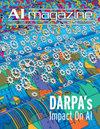Applying Few-Shot Learning for In-the-Wild Camera-Trap Species Classification
IF 2.5
4区 计算机科学
Q3 COMPUTER SCIENCE, ARTIFICIAL INTELLIGENCE
引用次数: 0
Abstract
Few-shot learning (FSL) describes the challenge of learning a new task using a minimum amount of labeled data, and we have observed significant progress made in this area. In this paper, we explore the effectiveness of the FSL theory by considering a real-world problem where labels are hard to obtain. To assist a large study on chimpanzee hunting activities, we aim to classify various animal species that appear in our in-the-wild camera traps located in Senegal. Using the philosophy of FSL, we aim to train an FSL network to learn to separate animal species using large public datasets and implement the network on our data with its novel species/classes and unseen environments, needing only to label a few images per new species. Here, we first discuss constraints and challenges caused by having in-the-wild uncurated data, which are often not addressed in benchmark FSL datasets. Considering these new challenges, we create two experiments and corresponding evaluation metrics to determine a network’s usefulness in a real-world implementation scenario. We then compare results from various FSL networks, and describe how factors may affect a network’s potential real-world usefulness. We consider network design factors such as distance metrics or extra pre-training, and examine their roles in a real-world implementation setting. We also consider additional factors such as support set selection and ease of implementation, which are usually ignored when a benchmark dataset has been established.应用少镜头学习进行野外相机陷阱物种分类
FSL (Few-shot learning)描述了使用最少的标记数据学习新任务的挑战,我们已经观察到在这一领域取得了重大进展。在本文中,我们通过考虑一个难以获得标签的现实问题来探讨FSL理论的有效性。为了协助一项关于黑猩猩狩猎活动的大型研究,我们的目标是对出现在我们位于塞内加尔的野外相机陷阱中的各种动物进行分类。利用FSL的理念,我们的目标是训练一个FSL网络来学习使用大型公共数据集分离动物物种,并在我们的数据上使用新物种/类别和看不见的环境实现网络,只需要标记每个新物种的一些图像。在这里,我们首先讨论由未经整理的野外数据引起的约束和挑战,这在基准FSL数据集中通常没有得到解决。考虑到这些新的挑战,我们创建了两个实验和相应的评估指标,以确定网络在现实世界实现场景中的有用性。然后,我们比较了来自各种FSL网络的结果,并描述了可能影响网络潜在现实用途的因素。我们考虑网络设计因素,如距离度量或额外的预训练,并检查它们在现实世界的实现设置中的作用。我们还考虑了其他因素,如支持集选择和实现的便利性,这些通常在建立基准数据集时被忽略。
本文章由计算机程序翻译,如有差异,请以英文原文为准。
求助全文
约1分钟内获得全文
求助全文
来源期刊

Ai Magazine
工程技术-计算机:人工智能
CiteScore
3.90
自引率
11.10%
发文量
61
审稿时长
>12 weeks
期刊介绍:
AI Magazine publishes original articles that are reasonably self-contained and aimed at a broad spectrum of the AI community. Technical content should be kept to a minimum. In general, the magazine does not publish articles that have been published elsewhere in whole or in part. The magazine welcomes the contribution of articles on the theory and practice of AI as well as general survey articles, tutorial articles on timely topics, conference or symposia or workshop reports, and timely columns on topics of interest to AI scientists.
 求助内容:
求助内容: 应助结果提醒方式:
应助结果提醒方式:


